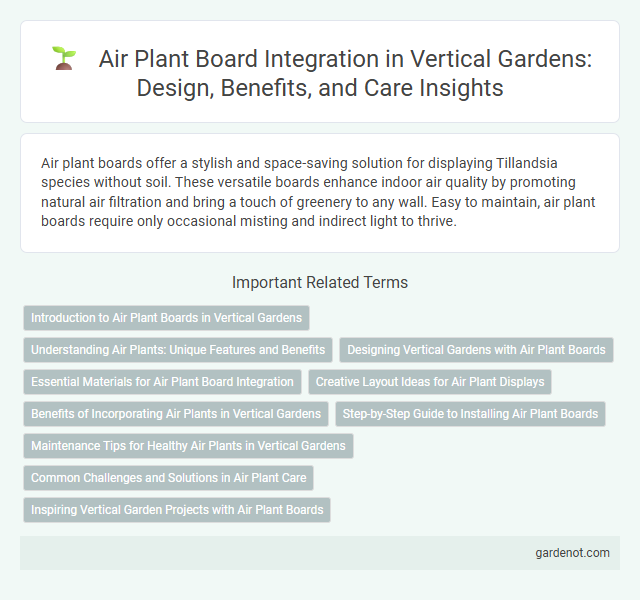Air plant boards offer a stylish and space-saving solution for displaying Tillandsia species without soil. These versatile boards enhance indoor air quality by promoting natural air filtration and bring a touch of greenery to any wall. Easy to maintain, air plant boards require only occasional misting and indirect light to thrive.
Introduction to Air Plant Boards in Vertical Gardens
Air plant boards offer a unique and low-maintenance solution for vertical gardens by securely mounting Tillandsia specimens without soil. These boards, often made from wood or cork, provide optimal air circulation and moisture retention crucial for air plants' health. Ideal for both indoor and outdoor installations, air plant boards enhance vertical garden aesthetics while promoting sustainable, space-saving greenery.
Understanding Air Plants: Unique Features and Benefits
Air plants, or Tillandsia, are epiphytic plants that absorb moisture and nutrients through their leaves, eliminating the need for soil. Their unique ability to thrive with minimal care makes them ideal for vertical garden air plant boards, enhancing indoor air quality and adding a striking, low-maintenance green element. These plants promote oxygen production and natural humidity regulation, making them beneficial for both aesthetic and environmental purposes.
Designing Vertical Gardens with Air Plant Boards
Designing vertical gardens with air plant boards maximizes space efficiency while providing low-maintenance greenery ideal for indoor settings. These boards, made from sustainable materials, host Tillandsia species that absorb moisture and nutrients from the air, eliminating the need for soil. Integrating vibrant air plant boards into home or office decor enhances aesthetics and improves air quality by naturally filtering pollutants.
Essential Materials for Air Plant Board Integration
Essential materials for air plant board integration include a sturdy wooden or metal frame to provide structural support and moisture resistance. Incorporating materials like sphagnum moss or coconut coir helps retain humidity necessary for air plant health. Using non-toxic adhesives and corrosion-resistant screws ensures durability and safety for both plants and indoor environments.
Creative Layout Ideas for Air Plant Displays
Air plant boards transform indoor spaces with customizable, creative layouts that showcase vibrant Tillandsia varieties on wood, metal, or slate surfaces. Arranging air plants in geometric patterns or themed clusters enhances visual appeal while optimizing airflow and sunlight exposure for healthy growth. Incorporating moss, driftwood, or pebbles around these boards adds texture and natural contrast, elevating the overall vertical garden aesthetic.
Benefits of Incorporating Air Plants in Vertical Gardens
Air plant boards enhance vertical gardens by providing low-maintenance greenery that thrives without soil, making them ideal for indoor environments with limited space. Their natural ability to purify air improves indoor air quality, while their unique appearance adds modern, aesthetic appeal to any vertical garden arrangement. Incorporating air plants also promotes biodiversity and requires minimal watering, ensuring sustainability and ease of care.
Step-by-Step Guide to Installing Air Plant Boards
Mounting an air plant board begins with selecting a sturdy backing material such as wood or cork to ensure proper support and ventilation. Securely attach air plants using non-toxic adhesives, wire, or fishing line, allowing enough space for growth and easy maintenance. Position the board in a bright, well-ventilated area with indirect sunlight and mist the plants regularly to maintain optimal humidity levels.
Maintenance Tips for Healthy Air Plants in Vertical Gardens
Air plant boards require minimal watering, typically a thorough soak once every 1-2 weeks, allowing plants to dry completely to prevent rot. Ensuring adequate indirect sunlight and good air circulation promotes air plant health and growth in vertical garden setups. Regular removal of dead leaves and occasional misting during dry periods also supports longevity and vibrancy of air plants on the board.
Common Challenges and Solutions in Air Plant Care
Air plant boards often face challenges such as insufficient light, improper watering, and poor air circulation, which can lead to mold growth or plant decay. To overcome these issues, placing the board in bright indirect light, misting the plants regularly while avoiding overwatering, and ensuring adequate airflow around the board are essential. Using materials that facilitate drainage and mounting techniques that prevent water retention can also enhance the health of air plants on vertical garden boards.
Inspiring Vertical Garden Projects with Air Plant Boards
Air plant boards revolutionize vertical gardens by combining modern design with low-maintenance greenery, perfect for urban interiors and small spaces. These boards showcase Tillandsia varieties that thrive without soil, enhancing air quality while creating captivating living art. Creative installations often blend natural wood, metal grids, and customizable layouts to inspire unique, sustainable decor solutions.
Air plant board Infographic

 gardenot.com
gardenot.com